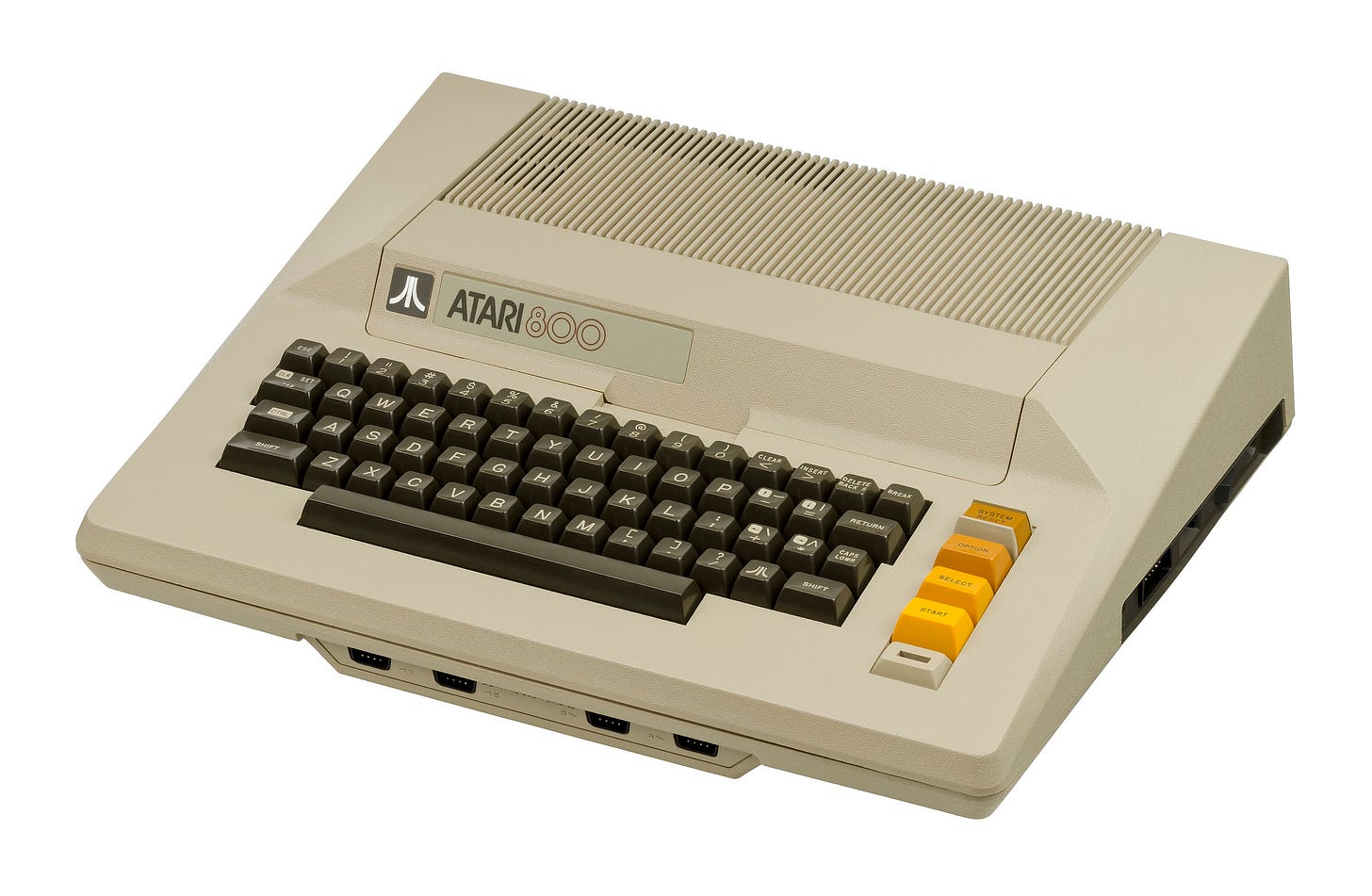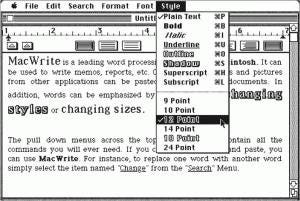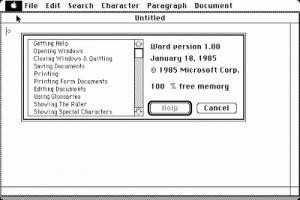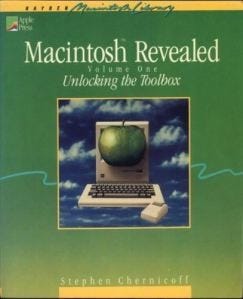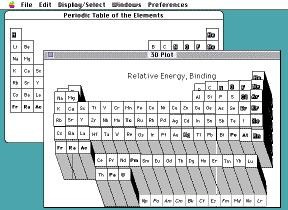[214.] Hello. Happy Anniversary Macintosh!
Happy 40th Anniversary, Macintosh! I was lucky enough to be at one of the right places at the right time and thought I'd share my story of why 1984 was not going to be like "1984".
The Apple Macintosh Super Bowl ad ran on January 22, 1984. Steve Jobs showed off Macintosh in person at the Flint Center in De Anza College, Cupertino, on Tuesday, January 24, 1984. I was a freshman in college, working in the shared computer facility. Here’s my story. Some of this was originally posted on LinkedIn a decade ago.
For me, January 1984 was the year of Van Halen’s “incredible” album, The Right Stuff, and the start of my second semester of college. It would also prove to be a time of enlightenment for me and computing. On this 40th anniversary of the Apple Macintosh on January 24 and Super Bowl commercial on January 22, I wanted to share my own story of the way the introduction of the Macintosh profoundly changed my path in life.

Perhaps a bit indulgent, bit it seemed worth a little backstory. I think everyone from back then is feeling a bit of nostalgia over the anniversary of the commercial, the product, and what was created.
High School, pre-Macintosh
Like many Dungeons and Dragons players my age, my first exposure to post-Pong computing was an Atari 800 that my best friend was lucky enough to have (our high school was not one to have an Apple ][ which hadn’t really made it to suburban Orlando). While my friends were busy listening to the Talking Heads, Police, and B-52s, I was busy teaching myself to program on the Atari. Even though it had the 8K BASIC cartridge it lacked tape storage. Every time I went over to use the computer I had to start over. Thinking about business at an early age (I suppose) I would continue to code and refine what I thought would be a useful program for our family business, the ability to compute sales tax on purchases from different states. Enter the total sale, compute the sales tax for a state by looking up the rate in a table.
My father, an entrepreneur but hardly a technologist, was looking to buy a computer to “automate” our family business. In 1981, he characteristically dove head first into computing and bought an Osborne I. For a significant amount of money ($1,795, or $4,600 today) we owned an 8 bit CPU and two 90K floppy drives and all (five) of the business programs one could ever need.
I started to write a whole business suite for the business (inventory, customers, orders) in BASIC which is what my father had hoped I would conjure up (in between SATs and college prep). Well that was a lot harder than I thought it would be (so were the SATs). Then I discovered dBase II and something called a “database” that made little sense to me in the abstract (and would only come to mean something much later in my education). In a short time I was able to create a character-based system that would be used to run the family business.
To go to college I had a matching Osborne I with a 300b (~30 bytes per second) modem so I could do updates and bug fixes (darn that shipping company–they changed the rate on COD shipments right during midterms which I had hard-coded!).
College Fall Semester
I loaded up the Osborne I and my Royal typewriter/daisy wheel/parallel port “letter quality” printer and was off to sunny Ithaca.
Computer savvy Cornell issued us our “BITNET electronic mail accounts”, mine wasTGUJ@CORNELLA.EDU. Equal parts friendly, memorable, and useful and no one knew what to do with them. The best part was email ID came printed on a punch card. As a user of an elite Osborne I felt I went back in time when I had to log on to the mainframe from a VT100 terminal. The only time I ever really used TGUJ was to apply for a job with Computer Services.
I got a job working for the computer services group as a Student Terminal Operator (STO). I had two 4 hour shifts. One was in the main computer science major “terminal room” in Upson Hall featuring dozens of VT100 terminals. The other shift was Friday night (yes, you read that correctly) at the advanced “lab” featuring SGI graphics workstations, IBM PC XTs, an Apple Lisa, peripherals like punch card machines, and a 5′ tall high-speed printer. For the latter, I was responsible for changing the ribbon, a task that required me to put on a mask and plastic arm-length gloves.
It turned out that Friday night was all about people coming in to write papers on the few IBM/MS-DOS PCs using WordPerfect. These were among the few PCs available for general purpose use. I spent most of the time dealing with graduate students writing dissertations. My primary job was keeping track of the keyboard templates that were absolutely required to use WordPerfect. This experience would later make me appreciate the Mac that much more.
In the computer science department I had a chance to work on a Xerox Star and Alto (see below) along with Sun Workstations, microVAX mini, and so on. The resources available were an incredible blessing to the curious. The computing world was a cacophony of tools and platforms with the vast majority of campus not yet tapping into the power of computing and those that did were using what was most readily accessible. Cornell was awash in the sea of different computing platforms, and to my context that just seemed normal, like there were a lot of different types of cars. This was especially apparent from my vantage point in the computer facilities.
One experience with a new, top-secret, computer was about to change all that.
I ended up getting to use a new computer from an unidentified company. One night after my shift, a fellow STO dragged me back to Upson Hall and took me into a locked room in the basement. There I was able to see and use a new computer. It was a wooden box attached to a wall with an actual chain. It had a mouse, which was used on the Xerox and Sun workstations. It had a bitmap screen like a workstation. It had an “interface” like the Xerox. There was a menu bar across the top and a desktop of files and folders. It seemed small and much more quiet than the dorm-refrigerator sized units I was used to hearing.
What was really magical about it was that it had a really easy to use painting program that we all just loved. It had a “word processor”. It was much easier to use than the Xerox which had special keys and a somewhat overloaded desktop metaphor. It crashed a lot even after a short time using it. It also started up pretty quickly. Most everything we did with it felt new and different compared to all the other computers we used.
The end of the semester and exams approached. The few times and couple of hours I had to play with this computer were exciting. In the sea of computing options, it was definitely the most exciting thing I had experienced. Perhaps being chained to the wall added to the excitement, but there was something that really resonated with us. When I try to remember the specifics, I mostly recall an emotional buzz.
My computing world was filled with diversity, and complexity, which left me unprepared for the way the world was going to change in just the next six weeks.
Superbowl
To think about Apple’s commercial, one really has think about the context of the start of the year 1984. The Orwellian dialog was omnipresent. Of course as freshman in college we had just finished our obligatory compare/contrast the dystopian messages in Animal Farm, Brave New World, and 1984 not to mention the Cold War as front and center dialog at every turn. The country emerging from recession gave us all a contrasting optimism.
At the same time, IBM was omnipresent. IBM was synonymous with computing. Sure the Charlie Chaplin ads were great, but the image of computing to almost everyone was that of the IBM mainframe (CORNELLA was located out by the Ithaca airport). While IBM was almost literally the pillar of innovation (just a couple of years later, scientists at IBM would spell IBM with Xenon atoms), there was also great deal of distrust given the tenor of the time. The thought of a globally dominant company, a computer company, was uncomfortable to those familiar with fellow Cornellian Kurt Vonnegut’s omnipresent RAMJAC.
Then the Apple commercial ran. It was truly mesmerizing (far more so to me than the Superbowl). It took me about one second to stitch together all that was going on right before my eyes.
Apple was introducing a new computer.
It was going to be a lot different from the IBM PC.
The world was not going to be like 1984.
And most importantly, the computer I had just been playing with weeks earlier was, in fact, the Apple Macintosh.
I was so excited to head back to the terminal rooms and talk about this with my fellow STOs and to use the new Apple Macintosh.
Returning
Upon returning to the terminal room in Upson, Macs had already started to replace VT100s. First just a couple and then over time, terminal access moved to an emulation program on Macs (rumor had it that the Macs were actually cheaper than terminals!).
My Friday night shift was transformed. Several Macs were added to the lab. I had to institute a waiting list. Soon only the stalwarts were using the PCs. I started to see a whole new crowd on those lonely computer nights.

I saw seniors in Arts & Sciences preparing resumes and printing them on the ImageWriter (note, significantly easier to change the ribbon, which I had to do quite often every night). Those in the Greek System came by for help making signs for parties. Students discovered their talent with MacPaint pixel art and fat bits. All over campus signs changed overnight from misaligned stencils to ImageWriter printouts testing the limits of font faces per page.
I have to admit, however, I spent an inordinate amount of time attempting to recover documents that were lost to memory corruption bugs on the original MacWrite. The STOs all developed a great trouble shooting script and signs were posted with all sorts of guesses (no more than 4 fonts per document, keep documents under 5 pages, don’t use too many carriage returns). We anxiously awaited updates and students would often wait in line to update their “MacWrite disks” when word spread of an update (hey, there was no Internet download).
In short order, Macintosh swept across campus. Cornell along with many schools was part of Apple’s genius campaign on campuses. While I still had my Osborne, I was using Macintosh more often than not.
Completing College
The next couple of years saw an explosion of use of Macintosh across campus. The next incoming class saw many students purchasing a Mac at the start of college. Research funds were buying Macs. Everywhere you looked they were popping up on desks. There was even a dedicated store just off campus that sold and serviced Macs. People were changing their office furniture and layout to support using a mouse. Computer labs were being rearranged to support local printers and mice. The campus store started stocking floppy disks, which became a requirement for most every class.
Document creation had moved from typewriters and limited use of WordPerfect to near ubiquitous use of MacWrite practically by final exams that Spring. Later, Microsoft Mac Word, which proved far more robust became the standard.
The Hotel School’s business students were using Microsoft Mac Excel almost immediately.
The Chemistry department made a wholesale switch to Macintosh. The software was a huge driver of this. It is hard to explain how difficult it was to prepare a chemistry journal article before Macintosh (the department employed a full time molecular draftsman to prepare manuscripts). The introduction of ChemDraw was a turning point for publishing chemists (half my major was chemistry).
It was in the Chemistry department where I found a home for my fondness of Macintosh and an incredibly supportive faculty (especially Jon Clardy). The research group had a little of everything, including MS-DOS PCs with mice which were quite a novelty. There were also Macs with external hard drives.
I also had access to MacApp and the tools (LightSpeed Pascal) to write my own Mac software. Until then all my programming had been on PCs (and mainframes, and Unix). I had spent two summers as an intern (at Martin Marietta, the same company dBase programmer Wayne Ratliff worked!) hacking around MS-DOS writing utilities to do things that were as easy as drag and drop on a Mac or just worked with MacWrite and Mac Excel. As fun as learning K&R, C, and INT 21h was, the Macintosh was calling.
My first project was porting a giant Fortran program (Molecular Mechanics) to the Mac. Surprisingly it worked (perhaps today, equally surprising was the existence of a Fortran compiler). It cemented the lab’s view that the Macs could also be for work, not just document creation. Next up I just started exploring the visualizations available on the Mac. Programming graphics was all new to me. Programming an object-oriented event loop seemed mysterious and indirect to me compared to INT 21h or stdio.
But within a few hacking sessions (fairly novel to the chemistry department) the whole thing came together. Unlike all of the previous systems I used, the elegance of the Mac was special. I felt like the more I used it the more it all made sense. When I would bury myself in Unix systems programming it seemed more like a series of things, tricks, you needed to know. Macintosh felt like a system. As I learned more I felt like I was able to guess how new things would work. I felt like the bugs in my programs were more my bugs and not things I misunderstood.
The proof of this was that through the Spring semester my senior year I was able to write a program that visualized the periodic table of the elements using dozens of different variables. It was a way to explore periodicity of the elements. I wrote routines for an X-Y plot, bar charts, text tables, and the pièce de résistancewas a 2.5-dimensional perspective of the periodic table showing a single property (commonly used to illustrate the periodic nature of electron affinity). I had to ask a lot of friends who were taking computer graphics on SGIs for help! Still, not only had I just been able to program another new OS (by then this was my 5th or 6th) but I was able to program a graphical user interface for the first time.
MacMendeleev was born.
The geek in all of us has that special moment when at once you feel empowered and marvel at a system. That day in the spring of 1987 when I rendered a perspective drawing from my own code on a system that I had seen go from a chained down plywood box to ubiquity across campus was magical. Even my final report for the project was, to me, a work of art.
It wasn’t just the programming that was possible. It wasn’t just the elegance and learnability of the system. It wasn’t even the ubiquity that the Macintosh achieved on campus. It was all of those. Most of all it represented a tool that allowed me to realize some of my own potential. I was awful at Chemistry. Yet with Macintosh I was able to contribute to the department and probably showed a professor or two that in spite of my lack of actual chemistry aptitude I could do something (and dang, my lab reports looked amazing!). I was, arguably, able to learn some chemistry.
I achieved with Macintosh what became one of the most important building blocks in my education.
I’m forever thankful for the empowerment that came from using a “bicycle of the mind”.
What came next
Graduate school diverged in terms of computing. We used DEC VMS, though SmallTalk was our research platform. So much of the elegance of the Macintosh OS (MacApp and Lisa before that) was much clearer to me as I studied the nuances of object-oriented programming.
I used my Macintosh II to write papers, make diagrams, and remote into the microVAX at my desk. I also used Macintosh to create a resume for Microsoft with a copy of Microsoft Word I won at an ACM conference for my work on MacMendeleev.
When I made it to Microsoft I found a great many shared the same experience. I met folks who worked on Mac Excel and also had Macs in boxes chained to tables. I met folks who wrote some of those Macintosh programs I used in college. So many of the folks in the “Apps” team I was hired into that year grew up on that unique mixture of Mac and Unix (Microsoft used Xenix back then). We all became more than converts to MS-DOS and Windows (3.0 was being developed when I landed at Microsoft).
There’s no doubt our collective experiences contribute to the products we each work on. Wikipedia evendocuments the influence of MacApp on MFC (my first product contribution), which was by design (and also by design was where not to be influenced). It is wonderful to think that through tools like MFC and Visual Basic along with ubiquitous computing, Windows brought to so many young programmers that same feeling of mastery and empowerment that I felt when I first used Macintosh.
Fast-forwarding, I can’t help but think about today’s college students having grown up hacking the web but recently exposed as programmers to mobile platforms. The web to them is like the Atari was to me—programmable, understandable, and fun. The ability to take your ideas, connect them to the Internet, touch your creation, and make your own experience must feel like building a Macintosh program from scratch felt like to me. The unique combination of mastery of the system, elegance of design, and empowerment is what separates a technology from a movement.
For me, Macintosh was an early contributor to my learning, skills, and ultimately my self-confidence. Macintosh certainly changed my professional path in life. For sure, 1984 was not at all like 1984 for me.
Yes, of course I’m a PC (and definitely a Surface). Nothing contributed more to my professional life than the PC!
PS: How far have we come? Check out this Computer Chronicles from 1985 where the new Macintosh is discussed. So many people in this video.


